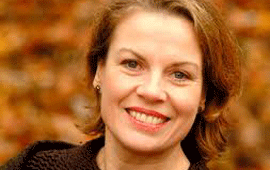> [Archived] Interviews

An Interview with the Mezzo-soprano Bernarda Fink
Mrs. Bernarda
Fink, we are honoured to have you as a guest in our programme. The
Romanian audience, due to international live broadcasts and
recordings, has been following your career. We would like you to tell
us about the most important moments related to the beginnings of your
career. What made you choose this path?
It was not that easy. I have to start by telling you that we are an artistic family. My parents are from Slovenia and after the Second World War; they were forced to leave their native country. They were Catholics and they didn’t want to support the new regime. So, my five siblings and I were born in Argentina. My parents used to sing all the time. My mother sang traditional Slovenian songs even while she was cooking for our numerous family. My father was also very musical; together with his three sisters, he sang lieder by Wolf, Schumann and Schubert, accompanied by my uncle, who was a pianist. So, I received music with my mother’s milk. However, it was a very long way from that point until becoming a professional singer.
In the ‘80s
you returned to Europe and that was the start of your successful
international career. Mrs. Bernarda Fink, you chose to focus in your
interpretations on vocal-symphonic works and lieder. Why this choice?
I think I have known this since the beginning of my career. I have really felt it. This kind of repertory has been right for me since my debut. When I started singing Bach, it felt good. It was love at the first sound and I knew that sacred music, the sacred repertory, were close to my heart. And the same can be said about the symphonic repertory. With the lyrical repertory there’s another story. I have a special love for opera, but I don’t particularly like the six weeks of rehearsals. I am a shy person. I find it difficult to initiate the collaboration with conductors or stage partners. That is why I prefer a more intimate dialogue, working in a more confined environment.
Your
repertory includes works by Bach, Handel and Monteverdi. What do
these creators signify to you?
It’s difficult to explain, because everyone approaches sacred music in a different emotional mood. We have to be really honest with ourselves, with our voices. I only accept to interpret a score if it tells me something. I need to be able to identify with the contents of that work. Sometimes it’s a contemporary work, other times it’s a Renaissance one. I have to tell you that Renaissance works, the opuses composed by Monteverdi or those of the 16th-17th centuries are quite beautiful. I haven’t interpreted this music in a long time. Maybe some day I’ll sing it again. For the moment I dedicate myself to Romanticism and post-Romanticism, Mahler and others. This change takes place inside you and it’s hard to explain it.
In
April 2014 you’ll launch a new album. What does it comprise?
It will include important lieder by Gustav Mahler – Kindertotenlieder (Songs on the Death of Children), with a big orchestra. There will also be some works belonging to the cycle Songs of a Travelling Journeyman orchestrated by Schönberg and other songs with piano accompaniment, in the author’s original version. For the recording of this album I worked together with the members of the Symphony Orchestra of the Lower Austria, the members of the Mahler ensemble and the pianist Anthony Spiri. We thought to bring together different sonorities and expressive colours, which correspond to Gustav Mahler’s creative fantasy. The piano and the orchestra were relevant to the contents of Mahler’s works and we’d like to invite the audience to enjoy these contrasts.
Translated by Mihaela Olinescu and Elena Daniela Radu
MTTLC, The University of Bucharest














